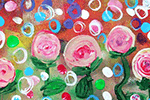The Children's Art Book
Building an Acrylic Painting
Depending on the composition of each painting, the sequence to building up a painting differs. Here are some general considerations.
Sketching quickly
Start your painting by gently drawing an image on the paper or canvas. Let your pencil dance lightly across, darkening lines as you become more confident of your drawing. Avoid reaching out for the eraser at this point! Instead, allow your child’s creativity to shine without restrain!
Start with Underpainting
Underpainting involves creating a layer of paint beneath the actual painting, usually used to create expressive undertones of a work. For example, if your painting has a lot of blue, try using luscious red paints in your underpainting!
As your painting goes over the layer of underpainting, the colours underneath will show through, creating a beautiful dimensional effect on the finished piece!
Paint in Layers
Layering a painting is to build the painting by adding layers, from bottom up. It is an important process in representational (or realistic) paintings, since layering make colours look energetic and lively, with rich depths and natural looking colours. Refine a painting by building up with more layers, increasing details on top of each layer of foundation.
Keep layers thin and light so that the acrylic paint dries quickly. Paint too thickly and drying time becomes lengthy and children will tend to get impatience.
Paint in blocks of colours
Unless it is a monochrome painting, a painting usually consists of many colours. To help children focus on completing the artwork, indicate all shapes with their colours on the painting at once, for example, “O” to represent orange and “G” to represent green. Create a palette family of colours, then paint in according to the blocks of colours, i.e. paint all greens first.
Painting in blocks of colours reduces time in washing colour off brushes due to painting different shapes, and can make painting fun and fast with a prepared palette!
Working from Back to Front
When creating landscapes in particular, work from back to front and paint everything in the background first, such as the skies and hills furthest from the front of the painting. Everything else in the foreground, such as trees, streams and grasslands, will overlap elements in the background. This helps the painting boundaries appear natural and convincing.
If you paint the foreground elements first, you cannot overlap the background elements since the streams become thinner and trees become shorter! In some cases, you become more wary about painting boundaries, leaving unpainted thin boundaries all around the canvases.
Finishing with the details
Although this sequence is usually the longest, children have the most fun finishing the details! Add layers of colours and textures with a variety of acrylic techniques and brush strokes. Make it more fun by using collage materials such as sponges, stamps, tissue paper, old letters and other materials found at home. Combining paint and collage materials are excitingly refreshing for children and achieve beautiful results.











